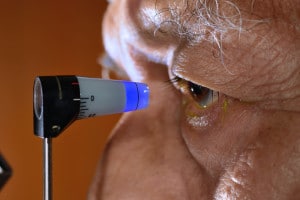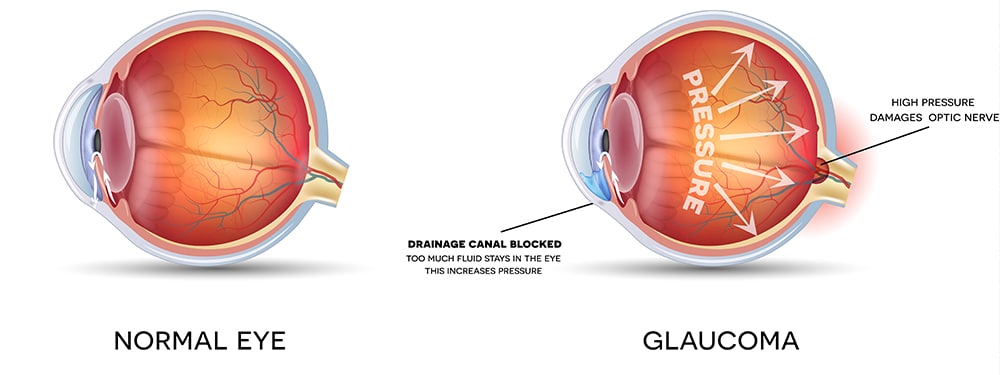Glaucoma is a disease that affects the optic nerve, the part of the eye which receives images collected by the retina and sends them to the brain. Every eye maintains a certain amount of internal pressure, called intraocular pressure. When this pressure rises to abnormal levels however, it can put extra stress on the optic nerve, causing significant damage. Optic nerve damage results in loss of vision, and ultimately blindness.
The front of the eye is constantly producing a fluid called aqueous humor. A healthy eye will continually produce small amounts of aqueous humor to ensure consistent pressure within the eye. When normal drainage becomes slowed or blocked, pressure increases, and may lead to glaucoma. There are several different types of glaucoma the two most common types being chronic open-angle glaucoma and closed-angle glaucoma.
Chronic open-angle glaucoma is the most common form of the disease and usually develops with age. With this type of glaucoma, pressure gradually increases around the eye causing it to work less effectively over a period of time. There are no symptoms in the early stages of open-angle glaucoma. Peripheral vision is usually the first to deteriorate. As the disease becomes more advanced, blank spots begin to appear in one’s vision. If left untreated, it eventually develops to blindness. The best way to avoid serious vision loss is early diagnosis and treatment.
Risk factors for chronic open-angle glaucoma include:
- Advanced age.
- Family history of the disease.
- Higher-than-normal intraocular pressure.
- Certain ethnic races, particularly those of African descent.
- Certain diseases or conditions, especially diabetes, farsightedness or nearsightedness, or previous eye trauma or surgery.
Closed-angle glaucoma is less prevalent, but is considered a real eye emergency. This type of glaucoma occurs when a patient’s pupil moves or dilates and actually blocks off the drainage angles in the eye. This is considered a medical emergency in which an ophthalmologist should be contacted immediately to avoid any loss of vision.
Symptoms of closed-angle glaucoma include:
- Severe eye pain.
- Headache.
- Blurred vision.
- Nausea or vomiting.
- Rainbow halos around lights.
High risk factors for closed-angle glaucoma include:
- Extreme farsightedness.
- An iris that is abnormally large or far back in the eye.
- Advanced age.
- Heredity.
- Certain ethnic races, especially Asians.
If you are experiencing any symptoms of glaucoma, we encourage you to contact Takle Eye Group in Griffin, GA today to schedule a consultation.

There are a wide range of treatments for glaucoma, including medication, laser surgery and traditional surgery. The treatment (or combination of treatments) for an individual is chosen based upon the type of glaucoma and other details of the particular case. One option is medication such as prescription eye drops which help to reduce intraocular pressure, or pills called carbonic anhydrase inhibitors which slow down fluid production within the eye.
Laser surgery has also become a common treatment option for glaucoma. For open-angle glaucoma the doctor may choose a trabeculoplasty, a painless laser procedure which uses light to shrink and stretch eye tissue to allow more drainage of fluid. For closed-angle cases, in which the iris is blocking drainage of aqueous humor, a laser surgery called iridotomy may be preformed.
Other glaucoma treatment options involve various traditional glaucoma surgeries. A common surgery for open-angle glaucoma is the trabeculectomy, where a doctor creates a small flap in the sclera (white part of the eye). Underneath the surface of the sclera, the doctor creates a small reservoir, called a filtration bleb, into which aqueous fluid may drain and then be disbursed, further reducing intraocular pressure.
There are a number of treatments available for Glaucoma patients. If diagnosed with glaucoma, your ophthalmologist will consult with you on your options in order to maintain the best possible health of your eyes.
If you are experiencing any symptoms of glaucoma, we encourage you to contact us today to schedule a consultation.
iStent Procedure
A glaucoma diagnosis can be scary. Being uncertain about the future of your vision is something no one wants to deal with. Now, add that to a cataract diagnosis and you can imagine the stress. Fortunately, Takle Eye Group is offering a once-in-a-lifetime opportunity to correct cataracts and treat glaucoma during one procedure. The iStent® may be for you.
What is glaucoma?

Glaucoma occurs when there is a build-up of pressure inside of the eye. Typically, this pressure build-up happens when there is a blockage in the eye’s natural drainage system. Fluids inside of the eye begin to build up and increase eye pressure. As eye pressure increases, causing the eye to swell, the eye pushes up against the optic nerve. This can cause great damage to the optic nerve, which is irreversible. Glaucoma causes thousands of cases of blindness each year.
What are cataracts?
Cataracts occur in most people as they reach their 60s and 70s. The natural crystalline lens inside of your eye, situated behind your pupil, is responsible for refracting light onto the retina for clear vision. In order to maintain clear vision, this lens must remain crystal clear. As we age, this lens begins to fog up and become opaque. This keeps light from getting into the eye and can greatly affect vision.
What is iStent®?
iStent® is a tiny implant that allows the eye to drain fluid and relieve intraocular pressure. The iStent® can be implanted during your cataract surgery, so you don’t have to worry about two separate procedures! With iStent®, patients are able to maintain a normal eye pressure.
How does it work?
iStent® creates a bypass between the front part of the eye and its natural drainage pathway. This allows fluids to move around normally, and significantly lowers intraocular pressure. By lowering the intraocular pressure, damage to the optic nerve ceases.
The Procedure
iStent® is implanted in the eye during cataract surgery. The procedures will be performed under local anesthesia. Your surgeon will go about cataract surgery normally. Once the cataract is removed, your surgeon will implant the iStent® device. You will not be able to see or feel the iStent® device once implanted.
If you have been diagnosed with glaucoma and you are interested in the iStent® procedure, be sure to give Takle Eye Group in Griffin, GA a call. Takle Eye Group also offers glaucoma treatments such as open angle glaucoma surgery (SLP) and narrow angle glaucoma surgery (LPI). If you are looking for other glaucoma treatments such as trebulechtomy (filtration surgery) or tube shunt surgery, we are happy to refer you to a trusted specialist.




